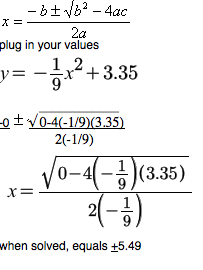

Okay, so we know why we should embrace the quadratic formula, but how do we use it to solve quadratic equations?

In the real world, the quadratic formula can be used for finding the speed of a moving object, studying lenses and curved mirrors, or even charting the path of a rocket launching into space! You might be surprised by how often the quadratic formula is actually used. There are other methods, like factoring or completing the square, but the quadratic formula is usually the most straightforward (and least messy) way to solve a quadratic equation.Īnd, contrary to popular belief, the quadratic formula does exist outside of math class. The quadratic formula, as you can imagine, is used to solve quadratic equations. We’ll start with our “why” so that we can keep that in mind as we move forward - and really, isn’t the “why” always the most important part? What is the quadratic formula used for?
#Standard form of quadratic equation how to
Now that we know how to identify and classify quadratic equations, let’s get into the quadratic formula. The other requirement for a second-order polynomial is that $$a$$ does not equal zero ($$a ≠ 0$$).įun fact: The graph of a second-order polynomial is a parabola! Second-order polynomialsĪ second-order polynomial has all the required elements of a polynomial (variables, coefficients, and exponents) arranged in a very specific format: That’s what puts the “quadratic” in “quadratic equation” - because the variable $$x$$ is squared. What is a quadratic in math?Ī “quadratic” is also a type of problem more specifically, it’s one that deals with squaring a variable, or multiplying that variable by itself. In fact, they’re the only second-degree polynomial equations! Why? Because a quadratic equation is made up of variables, coefficients, and exponents, and the highest exponent is $$2$$. So, quadratic equations are pretty unique - they’re second-degree polynomial equations.

Specifically, it’s an equation made up of variables, coefficients, and exponents. That just means that the greatest power (or exponent) in the equation is $$2$$, like $$x^2$$.īut that’s not all: a quadratic equation is also a polynomial equation! A polynomial equation is also a type of equation. Let’s talk about a few: Second-degree equationsĪ second-degree equation is a type of equation, and the quadratic equation is considered a second-degree equation. That tiny little “$$2$$” is actually hugely important for placing quadratic equations within the greater context of equation types. Maybe you haven’t heard of a variable being “raised to the second power” before, but you’ve heard of a number or variable being “squared” or “raised to the power of $$2$$.” Lucky for you, they all mean the same thing!Ī variable raised to the second power will look like this:

But what does that really mean? And how do you recognize one on the page? Ready to learn quadratic equations? What is a quadratic equation?Ī quadratic equation is an equation in which the variable is raised to the second power. Trust us: giving yourself a little grace will make a world of difference. Allow yourself the time and space to move past that initial shock, and really sit with the information. That said, we know “interesting” can often start out as “confusing.” If that’s where you find yourself, we’re glad you’re here.Īs we start to walk through equations and formulas, it might look overwhelming at first. If you’re just starting to work with quadratic equations, we’re excited for you! That means your algebra adventure is really starting to get interesting (and we do mean “interesting” in a good way!). Quadratic Equations: Formula, Use, Examples, and Solutions


 0 kommentar(er)
0 kommentar(er)
